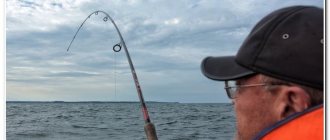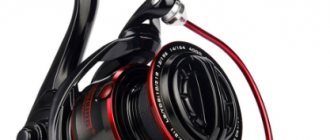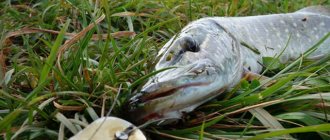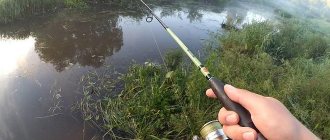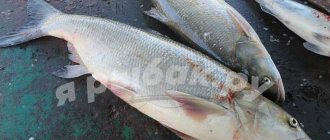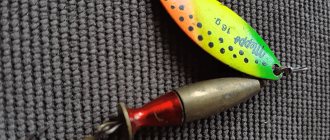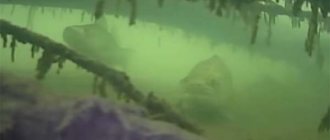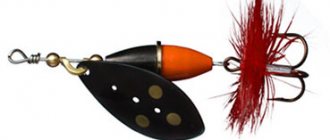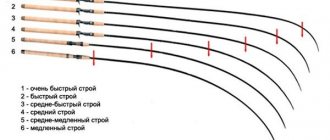Content
- Spinning ultralight
- Spinning rod length
- Spinning rod weight
- Spinning test
- Line test
- Spinning rod structure
- Rating of the best models. The professionals say
- Video: Fishing with ultralight spinning rod
- Find out more about the different models. Reviews about spinning rods
Mastering a new fishing method is not always easy. It’s great if there is someone nearby who will tell you about all the subtleties and nuances, but what if there is no such person? In this case, you have to resort to advice “from the Internet”. This material acts as an “assistant”, which contains not only Internet materials, but also the opinions of practicing fishermen and microjig lovers.
Why is microjig needed at all?
This question is asked by many who have not yet started microjig fishing. Indeed, is microjig as in demand as they sometimes write about it? For a long time I myself was skeptical about microjigging - as it seemed to me then, it could not give any special advantages to the spinning angler. If the fish is active, it is much more interesting to catch it with wobblers or micro-oscillators. Well, when hunting for a passive predator, spaced-out rigs will help out - “Distraction leash” or drop-shot. Microjig, in the light of these ideas, was seen as a kind of alternative to the same “Retractable leash”, giving an advantage only in fishing speed, but losing in the ability to catch remote points, etc. And the need to buy a specialized spinning rod, which in principle would not be suitable for anything else, was a little annoying. And not so much in financial terms, but in inconvenience directly on the reservoir - after all, every extra spinning rod limits the mobility of the fisherman, especially when moving along wild banks overgrown with bushes and grass. In addition, the main catch of a microjig was then seen as an outright trifle, which is hardly of interest to an amateur spinning angler who does not participate in fishing and sporting events.
At the same time, I came across the positive aspects of microjig more and more often. Then, on a fairly long stretch of shore, the only angler with at least some catch was a fan of microjig. At the competitions where I was, victory went to fans of microjig, while fans of spinners or lead rigs didn’t even see any bites. For me, during periods of no biting, the only working bait was a twister on a light jig head, which I was able to cast and animate passably using a regular ultralight spinning rod. At this point, willy-nilly, you’ll think that you can’t do without mastering this method.
The turning point in my “micro-jigging career” was the winter season of 2011-12. The presence of an ice-free—and at the same time very fishy—section of the Moscow River literally within walking distance (just an hour by metro) made it possible not to close the spinning season at all. I already had some experience with micro-jigging - in the summer season I managed to catch fish regularly with ultra-light jig baits, and not without success. So, with the onset of cold weather, the microjig could well compete with the regular jig and the “Tap Leash,” which is what happened, and in a very clear form.
It all started with a mini-festival organized by visitors to the forum of the newspaper “Rybak Rybaka”. Among the gear I brought to the festival was a microjig spinning rod, which I didn’t have much hope for - the rest of the participants had not fished with a microjig before, so there was a high probability that the results would be very modest. Everything turned out exactly the opposite - the microjig completely beat both the lead rigs and the classic light jig. We still managed to catch about a dozen perch using the “Otvodnoy” and split-shot, but the “microjigits” caught several times more. Of course, such outstanding results forced many to reconsider their attitude towards microjig. Suffice it to say that by the next festival all participants had already acquired specialized spinning rods (photo 1).
However, it’s not just about the festival. Almost the entire winter season, predatory fish clearly gravitated towards light jig baits, while the “Discharge Leash” showed very unstable results. Even at proven points, where good catches were always made, bites with lead rigs could not be seen, while perches literally lined up for microjig baits (photo 2). In addition, the abandonment of the “Diversion Leash” made it possible to significantly diversify the catches. If the main “lead” fish within the boundaries of Moscow is definitely perch, then the microjig was equally successful in hauling perch, pike perch, and goby, and there were so many fanged ones in the catches that it was time to think that this year there was a noticeable jump in its numbers (photo 3).
As a result, we can now safely say that microjigging is not only a universal way to get away from scratch in almost any fishing, but also a truly exciting, exciting and dynamic method of spinning fishing that will develop, gain new fans every year, improve technically and tactically . First of all, residents of large cities should pay attention to it - the fish in our reservoirs, unfortunately, are becoming less and less every year, and the number of people who want to catch them is only growing. Of course, microjig is unlikely to be an absolute panacea for lack of biting, but that it can significantly improve fishing performance is for sure. So, for those who have not yet encountered this method, I recommend giving it a try. Well, in order for mastering microjig to be most effective, I dare to give a few recommendations.
Spinning ultralight
A spinning rod for microjig fishing is a very delicate tackle, thanks to which fishermen can use ultra-light baits. Ultralight, or as it is briefly called, UL, literally translates as “ultralight”.
Micro baits are more readily attacked by fish, so even on the most unfavorable day for fishing, the probability of catching fish with ultralight is higher. Of course, a fisherman is unlikely to be able to catch a serious trophy with an ultralight spinning rod, but fish up to 4-5 kilograms are quite capable.
In this article, based on the opinion of practicing microjig fishermen, we will learn how to choose the right ultralight spinning rod and what it affects:
- Length;
- Weight;
- Blank test;
- Line test;
- Build.
2. Daiwa Gekkabijin MX 74UL-S | Price 12,000 rub.
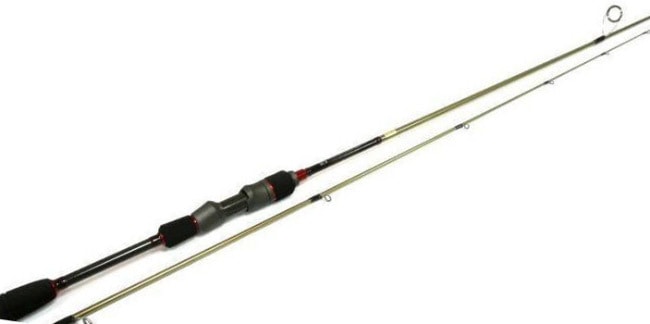
spinning rods for microjig include Daiwa Gekkabijin MX 74 UL – S. The length of the rod is 2.24 m, weight – 83 g. The model has a pleasant and laconic design and good assembly. The rod is equipped with a comfortable skeletal reel seat. High sensitivity makes the Daiwa Gekkabijin an ideal tool for catching small and medium-sized fish using a microjig.
The average cost of a spinning rod is 12,000 rubles.
Spinning rod weight
- What is this. Weight of spinning rod without reel, cord and bait.
- What is it measured in? In grams.
- Which to choose. Microjig is working with light bait weights, thin lines, and small reels. All this means that the weight of the spinning rod must match the rest of the equipment. In practice, a spinning rod for microjig fishing rarely weighs more than 120-130 grams. There is no ideal value here. As experienced ultralight lovers say, the lighter the better.
Criterias of choice
For successful fishing, you need to consciously approach the selection of spinning rods. When choosing, you should pay attention to the following criteria:
- Dimensions, weight of the rod;
- Characteristics of the fishing line;
- Type of top;
- Passage rings;
- Parameters, handle type.
All characteristics of the above criteria will change depending on the specific fishing location. Before purchasing a spinning rod, you need to think about where the casting will take place: from land or to the middle of the reservoir.
Rod length
The length of the stick for both jig and microjig varies from 1.8 to 2.1 meters. If fishing is carried out from a boat, then you should choose a not so long one, since there is no need to cast over long distances.
- 1.5 - 2.1 m - for fishing from swimming devices;
- 2.1 - 2.4 m - universal, make it possible to fish in any conditions and are considered an excellent choice for beginners;
- 2.4 - 2.7 m - for fishing from land;
- 2.7 – 3 m – for professionals, designed for long-distance casting, also needed for participation in competitions.
Rod build
Its flexibility and the time required to respond to the onset of a bite will depend on the specified action of the fishing rod. The type of structure cannot be determined by appearance, it can only be felt.
Types of formation:
- Fast build. This option is most sensitive to the weakest bites. This rod is quite rigid, but its tip, on the contrary, is flexible. It is through this that information about the ongoing bite is received. You should not opt for a fast system if you plan to cast over long distances. With the help of such gear, the angler is most informed about the bite and can feel the current movements of the jig. Fast action is recommended for microjigging.
- Slow build. This type is designed for lovers of long, accurate casts. Their disadvantage is the loss of sensitivity and awareness of the passing bite.
Which system to choose depends on the individual preferences of fishing enthusiasts, but the best option would be combined ones. They can change their characteristics depending on the degree of load. When it decreases, it will perform the functions of a fast action rod. If there is a need to cast over long distances, it will reduce sensitivity, which is typical for a slow action.
Spinning rod weight
It is advisable to choose spinning rods that are lighter in weight if possible. They are equipped with thin cords and light reels. For microjig, fishing rods should weigh 120-130 grams. First-class ones do not exceed 100 grams.
Rod tips:
- Tubular or hollow. They are installed on stiffer rods and are recommended to be used with weights of 4 grams or more.
- Complete “paste”. It is softer and allows you to observe the behavior of the bait. It is better to select a load for it with light weights.
Rod test
The test is a determination of the mass of the load that can be thrown to the required point in the reservoir without damaging the fishing rod. The higher the test score, the more weight you can use while fishing.
Test categories:
- Trolling jig involves using a weight of more than 50 grams;
- Heavy jig involves using a weight of over 20 grams;
- The average jig allows you to apply a weight of 10-25 grams;
- A light jig is a weight weighing 5-10 grams;
- Microjig. Recommended weights for it are 1-10 grams.
Line test
For fishing rods designed for this type of fishing, the choice of fishing line is very important. Experts do not recommend using a cord with a breaking load higher than the specified value. This will result in equipment failure.
Passing rings
For these types of fishing, they are very picky about the choice of guide rings. They should be characterized by lightness and ideal quality. Fuji is considered the best manufacturer. Most often, jig rings have small diameters.
Spinning rod handle
There are two types of handles for spinning rods: spaced and solid. For jig fishing, it is better to choose a spaced handle. It is lighter than solid and has high sensitivity. Fishermen prefer handles made of neoprene as they are more durable and cheaper.
Spinning test
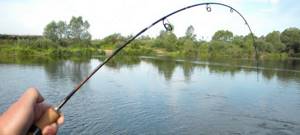
- What is this. This is the weight range of lures that the spinning rod “works” comfortably with. It throws easily, you can feel the wiring.
- What is it measured in? The minimum and maximum values are grams.
- Which to choose. Fishing with microjig is an ultra-light type of fishing, which involves using a weight range from 1 to 5 g. Let’s add a couple of grams to the bait. In general, no more than 6-7 g.
Major Craft Crostage CRK-S732M
An excellent option for a microjig rod for relatively little money. The blank of this model is made of lightweight HMC carbon fiber, Fuji guide rings with SiC inserts are installed, and the tip is glued in. With a length of 220 cm, the rod weighs only 88 g; the test indicator is 1-5 g.
Thanks to its high sensitivity, the spinning rod allows you to carefully control the play of light silicones and record the slightest bites. At the same time, the CRK-S732M cannot be accused of being fragile or unreliable; the model is quite powerful and durable.
Line test
- What is this. A parameter showing which cords/lines the rod will work comfortably with. If you put a cord thicker than specified, then the spinning rod will break on the hook/pull/fast fish, and the cord will not break, as it should be.
- What is it measured in? Meaning Linetest (from the English. Line test). It is usually indicated in pounds (1 lb = 0.453 kg).
- Which to choose. When fishing with a micro jig, it is best to choose a fishing line or line with a medium tensile strength. This will protect you from breaking the spinning rod while fishing or hooking.
Spinning rod structure
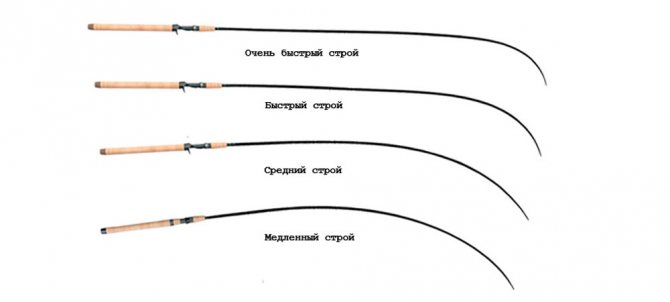
What is this. Bending of a certain part of the form under static load.
What is it measured in? There are three main categories: fast, medium, slow. However, there are also subcategories (slow, medium-slow, medium, fast, super-fast, ultra-fast, etc.)
Which to choose. Let's look at the main categories and find out how to define them.
- Slow parabolic (slow). It bends well along its entire length, from the tip almost to the handle.
- Average (medium or moderate). Bends from the tip to the middle of the rod.
- Fast. Only the tip bends.
- There is another category - ultra-fast. This is a spinning rod that practically does not bend.
The classic ultralight microjig spinning rod is generally recognized as a fast rod with a glued tip.
The spinning rod structure for microjigging is often chosen to be fast - it is a fairly rigid blank and a relatively soft glued-in tip.
5. Graphiteleader Tiro Prototype GOTPS-762L-T | Price 17,300 rub.

Graphiteleader Tiro Prototype GOTPS -762 L – T is another excellent spinning rod model for microjig from the famous Japanese brand. The length of the rod is 2.29 m, weight – 95 g.
This is a premium spinning rod for those who value excellent quality and do not skimp on the best. The advantages of the model include:
- excellent build quality;
- high quality materials;
- excellent rod sensitivity;
- original design.
Disadvantages of the model: high price. The Graphiteleader Tiro Prototype costs about 17,300 rubles.
Rating of the best models. The professionals say
Today on the fishing tackle market there are a large number of spinning rods that are designed for ultralight fishing. At the beginning of the article, we talked about the fact that when choosing a spinning rod for yourself, you need to rely not only on “Internet knowledge”, but also on the advice of real fishermen. We have selected for you several expert opinions on this matter to make your choice of spinning rod as simple as possible.
Evgeniy Edynak (pon4ik666), member of the AngryBeavers team:
— I will build my TOP spinning rods for microjig according to price categories.
In 3rd place I would put Aiko Izabella 3 692ULS.

- Test: 0.7-5 grams
- Length: 2.06 m
At a low price, the spinning rod has good performance. The rod casts light baits well, and the solid tip allows for good control of the bait’s action on the lower test. A good tool for a person who is starting or wants to try microjigging.
In 2nd place I would put the Crazy Fish Ebisu Gold 602SUL spinning rod.
- Test: 0.6-3
- Length 1.83 m
This is the most delicate wand I have ever held and I fell in love with it almost immediately. The spinning rod has a very sensitive tip, which allows you to use ultra-light weights on micro jigs and jigs. Despite its short length, it has very good throwing qualities. The sensitive tip allows you to record the most accurate bites of the perch, the fishing of which is an insane pleasure.
In 1st place I would put the Team Salmo Tioga Small Game 712MF rod.
- Test: 0.4-5
- Length: 2.16 m
To put it in a nutshell, it’s a great rod. First of all, it looks great. Secondly, it shows excellent performance. Unlike the previous ones, this spinning rod has a tubular top, which allows it to be used with various baits. On a microjig, the rod hits the hand with a 3 gram worm bait on a 0.4# line. There is nothing to say about sensitivity when biting, everything is perfectly felt by hand. The only thing is that a skeleton reel seat does not fit everyone’s hand, but this is individual.
Vadim Marochkin (Altezz), member of the AngryBeavers team:
— My rating of good spinning rods for microjig is as follows.
4th place. Norstream Blaze.

I will not indicate a specific model, since I caught two different ones, and you will find other models in the series. The whole point of Blazes is spinning rods with thin tips and a thick butt. Ask why? Fishing with a microjig in conditions of snags, debris on the bottom and “thick fish”. When, after a bite, you can’t give the fish a chance and quickly reel in the fish. Plus, I prefer when the spinning rod is not of one direction, but can cope with something else. In this case, Blazes can, if necessary, be fished with jigs. Yes, it’s not ideal, but sometimes there are situations when it’s necessary. For beginner anglers with a small budget, this is a very good option.
3rd place. Aiko Isabella 3.
Here I’ll point out model 692UL - the youngest in the Isabel line. As the manufacturer points out, the difference from the previous version of Izabella 2 is in the redesigned handle. I didn’t catch the second one, so I can’t compare. But again, as an option for a budget spinning rod for microjigging for a beginner, it’s definitely worth paying attention to! First of all, I paid attention to the casting range - it was on point! According to the so-called sense of smell, a spinning rod can easily detect the fall of a bait weighing one and a half grams, and cautious bites of a perch.
2nd place. Aiko Tirrel 215 UL-S.
I don’t know how relevant this information will be now, Tirrells have been on the market for a long time, and I think everything has been known about them for a long time, but! For me, ultralight fishing began with this spinning rod. And if there seems to be nothing special to say about casting - it’s not a catapult, but it’s not underfoot either, then by “feeling”... It was the only spinning rod at the tip of which I could easily see a Cheburashka weighing 0.8 grams and a small worm fall to the bottom . This has never happened anywhere else with other spinning rods. From time to time I think about finding such a model, even if it’s used for sale, and restoring it in my arsenal. I still recommend it first when asked what to take for this type of fishing.
1 place. The clear leader on my list is the Norstream Provokator 582UL.
A spinning rod that rightfully deserves first place. Despite its rather short length - less than 1.8 meters, I don’t experience any problems with casting. In terms of scent, everything is also great, I always start fishing with two grams and, if necessary, I can go down to a gram + a small bait without problems or loss of quality. Need more weight? 4 grams + bulk bait also goes into the water without any problems. Should I fish with a jig? Not a problem at all for the Provocateur. Very small and stubborn wobblers - and it can handle it! With difficulty, but nevertheless. The only negative I can name is its price - now retail is about 16 thousand.
In general, the list could have been compiled from a much larger number of spinning rods. One simple tip - choose according to your fishing conditions and your budget!
Mikhail Zharov, (Shakespeare), host of the video blog FishingSib.ru:
— I’ve been looking for a microjig rod for quite a long time, from time to time, trying a variety of sticks from the top segment to budget options. Literally, quite recently, I found happiness by closing this question for myself.
As often happens, he closed with two fishing rods, one of which I had not even managed to purchase yet. But having borrowed it for competitions, I managed to understand that microjigging on reservoirs without a current, with a soft bottom - it simply covers me in the best possible way. This is Crazy Fish Ebisu Gold 602SUL.
- Test: 0.6-3 g
- Length 1.83 m
A fishing rod that I first tried on a big river and was disappointed that again I was not holding in my hands what I needed. In addition, my first impression of it was completed by the inserts of the rings, which were so wide during the extra-ultralight modification of the spinning rod that one might think that they were mixed up at the factory, taking those that should be on marine spinning rods, which are required to maintain the friction of the cord with a breaking load 100 kg when landing marlins.
But everything changed, oddly enough, exactly the opposite, after I arrived in the ChSFO in Omsk with the only spinning rod in the form of a CF Ebisu Gold 602SUL. Already during training, I realized that in Novosibirsk I simply did not meet the conditions. On the pond, this fishing rod opened up in a microjig so that I realized that same day that I did not need to further search for a fishing rod for pond and lake perch. This is just what the doctor ordered.
The second spinning rod turned out to be a one-piece Spinning Tict Sram UTR-61 One Lgd.
- Test: 0 - 3.5 g
- Length: 185 cm
I bought this ultralight spinning rod quite recently, mainly, again, for competitions in the format of 1 fish = 1 point, in which, as a rule, perch fishing is relevant. And a competitive bass is either an MJ or a jig.
The conditions of such an extreme event dictated fishing with a jig and the matter never came to Tikt. I didn’t want to experiment that day and took another fishing rod into battle. But after that, I spent several fishing trips with her on the rivers and here again the joyful signal “The search is over” occurred. This is exactly how I imagined its purpose - a fishing rod that, in the best way, covers the best fishing conditions in the current and without it, including in the wind.
Incredibly strict (which is quite a rare occurrence in XUL), weighing 58 grams, super-sensitive, having a very special glued top, in a one-piece design, it works wonders. I think that it is destined to open up during other fishing, but it works in an exemplary manner on rivers, in coastal areas, where traction is often present.
There is some discomfort during transportation, but the plumbing pipe partially resolves this issue.
Thus, after a long time of wandering, with two fishing rods, I completely covered the issue of XUL mj fishing. Sram and Ebisu are what I have been looking for for a long time. It remains to wait until free money appears to put Ebisu in line. And then the search for a fishing rod for a jig will continue...
Top 13 best spinning rods
Maximus High Energy-X
An excellent option at an affordable price, which will leave only positive emotions from use. The case is made of high-quality materials, which is rare for this price range. The device has two sections, there are no complaints about the external design, the fittings are of a high standard. Comes with 8 rings.
This is a great option for people who want to learn the basics of microjigging. Works with baits weighing from 1 to 7 grams. The only drawback is the slippery cover.
Average cost – 3,400 rubles.
Maximus High Energy-X
Advantages:
- External performance is up to par;
- Light weight;
- Possibility to use baits up to 7 grams;
- Comes with several rings;
- Quality at an affordable price;
- For amateurs and beginners.
Flaws:
- Inconvenient handle.
Maximus BW

An excellent model that came out last year and has gained popularity among amateurs and professionals. With a small weight of 100 grams, the product shows excellent results and makes it possible to work with bait up to 7 grams.
The maximum length is 2.1 meters, which is a balanced solution and will allow fishing from different places, including from the coastline. The set includes small anti-wrap rings that evenly distribute the weight along the entire length of the rod.
However, the main difference from the previous version is that the handle has an anti-slip coating. The tip has high sensitivity.
The average cost is 5,800 rubles.
Maximus BW
Advantages:
- A good option for beginners;
- Weight only 100 grams;
- High sensitivity;
- Optimal length;
- Anti-wrap rings.
Flaws:
- Not detected.
Norstream Element

When designing this device, special emphasis was placed on the equipment of the product; in addition, the manufacturer equipped the spinning rod with an ergonomic handle. The two-section fishing rod can change its length from 1.8 to 2.8 meters. But the optimal option for microjigging is 2 m; this must be taken into account if the product is purchased only for this.
The rod is presented in two series, the first option has a bait test from 6 to 23 grams, the second – 8-23 grams. To ensure maximum comfort, the handle is made of neoprene, which increases ease of use. The rings have an insert made of a special material that is wear-resistant. The maximum weight of the fishing rod is 148 g.
Sold at a price of 5,000 rubles.
Norstream Element
Advantages:
- Excellent appearance;
- Various bait test;
- Price;
- Adjustable length;
- Suitable for jigging.
Flaws:
- Not found.
Shimano Catana CX Spinning 270ML

The body is made of high-quality composite material, which shows high resistance to mechanical stress. The handle is made of cork, and the fittings are made of silicon carbide. This is an excellent jig spinning rod designed for beginners.
Its price allows everyone to buy the product, while the rod has impressive technical characteristics. The cast is made over a long distance, which is an advantage when fishing from the shore.
The minimum cost is 2,000 rubles.
Shimano Catana CX Spinning 270ML
Advantages:
- Made from quality materials;
- Good ergonomics;
- Long cast;
- Suitable for beginners.
Flaw:
- There are fakes.
Banax Thunder 90MXF2
An excellent rod with a plug-in design, made of durable graphite, will give the beginner an unforgettable fishing experience. The spinning rod is designed in such a way that it allows you to install bait up to 50 grams, which makes it possible to use a rod for jigging. The model has proven itself to be excellent among amateurs and beginners.
Average cost – 3,100 rubles.
Banax Thunder 90MXF2
Advantages:
- Made from graphite;
- Good guide rings;
- Value for money;
- Reliability.
Flaws:
- Not found.
Black Hole Hyper III S270

A good blank made of high-modulus carbon with high-quality guides. It is produced in Korea, therefore it has a low cost, which does not in any way affect the quality of workmanship. The sensitivity is good, the action of the rod is fast. Even at sub-zero temperatures, the spinning rod will not lose its positive qualities and will provide an opportunity to catch fish.
The average price is 7,000 rubles.
Black Hole Hyper III S270
Advantages:
- Reliable manufacturer;
- Technical characteristics correspond to the price;
- Length – 2.7 meters;
- Fast build.
Flaws:
- The knee connection mechanism is loosened.
Banax Mega MC90MHF2
A good two-legged spinning rod, which is equipped with a long body: 2.7 meters. But even with this value, the design stands out for its durability and sensitivity. Sold in two types: casting and spinning. The weight of the product is 142 g, but due to the correct distribution of weight, the fishing rod seems lighter.
Provides the user with accurate and long-distance casting. For greater convenience, the handle is made of cork. The body itself is made of carbon. The maximum weight of the bait is 7-75 g, which is an excellent indicator.
The average cost is 3,000 rubles.
Banax Mega MC90MHF2
Advantages:
- Test for bait up to 75 g;
- Price, considering the category;
- High strength rings;
- Easy.
Flaws:
- Not found.
Daiwa Neoversal 762MLFS

A high-quality device, which is equipped with two sections and has an optimal length of 2.3 meters, which will allow a beginner to discover all the delights of microjig fishing. Although the design has an unusually large weight (165 g), this does not affect convenient operation and casting range.
Thanks to its comfortable length, the device is convenient to use not only from the shore, but also from a boat. The shape of the handle is made while maintaining ergonomics; cork material was used in its manufacture. The bait test is from 5 to 15 grams, which opens up the possibility of using the product for catching almost any predatory fish.
The average cost is 5,100 rubles.
Daiwa Neoversal 762MLFS
Advantages:
- Optimal length;
- Affordable cost;
- Bait test – 5-15 grams;
- Reliability.
Flaws:
- Not found.
Zander ZRS-792M
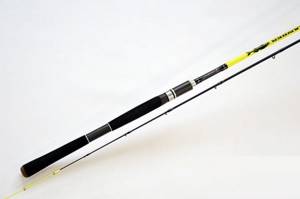
Excellent two-section spinning rods from a top company that are suitable for amateurs and professionals. The main difference between these models is their excellent build quality and casting range. The device also has a high-speed action and shows unique effectiveness when catching pike, pike perch and small wobblers.
The handle has an ergonomic shape, which will allow you to spend more time doing your favorite activity. The front part is made of graphite. The weight of the rod is 141 grams. The overall body is made of graphite.
The average cost is 11,000 rubles.
Zander ZRS-792M
Advantages:
- Reliability;
- Throw range;
- Light weight;
- Balanced parameters.
Flaws:
- Not found.
Graphiteleader Rivolta 772M
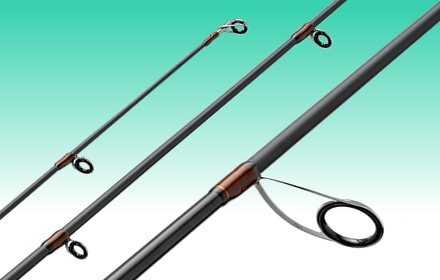
A more expensive model, which is made of high-modulus graphite. It has two elbows, and thanks to high-quality fittings and a comfortable handle, it will provide maximum comfort when fishing.
Production is carried out by a popular Japanese company, which speaks about the quality of the product only on the positive side. It is versatile and suitable not only for jig fishing.
Sold at a price of 13,000 rubles.
Graphiteleader Rivolta 772M
Advantages:
- Brand model;
- Beautiful appearance;
- Ergonomics are up to standard;
- Versatility.
Flaws:
- Not detected.
Pontoon21 Psychogun 912MMHSF

The spinning rod is made of Torai graphite, has excellent guides and a handle made of test material, which gives the owner quality and reliability. In order to prevent counterfeiting, the manufacturer has placed an individual number on the handle that prevents these actions.
Most amateurs, when choosing a spinning rod for jigging, prefer this option. Even though the casting range is not so high, the technical characteristics of the fishing rod leave its competitors behind. Spinning allows you to easily catch fish in the most difficult situations. The tip has excellent sensitivity.
The minimum cost is 7,000 rubles.
Pontoon21 Psychogun 912MMHSF
Advantages:
- High-quality assembly;
- Good technical performance;
- Good value for money;
- Durability.
Flaws:
- Not found.
Graphiteleader Tiro
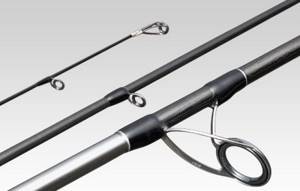
One of the best professional devices, which has proven itself excellent among masters of their craft. The design is completely balanced, which makes it possible to fish for a long period without hand fatigue. Despite the length of 2.3 meters, the rod is designed for fishing from the shore and from a boat, which gives it versatility.
The weight of the device is only 106 grams, while the upper element is sensitive, which allows you to respond even to small bites. To provide greater strength, the upper rings have a special frame made of durable metal, and the lower ones are made of stainless steel. Therefore, the product is durable and resistant to mechanical wear.
The average cost is 25,000 rubles.
Graphiteleader Tiro
Advantages:
- Only high-quality elements were used in production;
- The weight of the bait is 1-12 grams, this is a good solution for microjig;
- Used by professionals;
- Light weight;
- Durable rings.
Flaws:
- Not detected.
Saint Croix Legend XTreme LXS70MF2
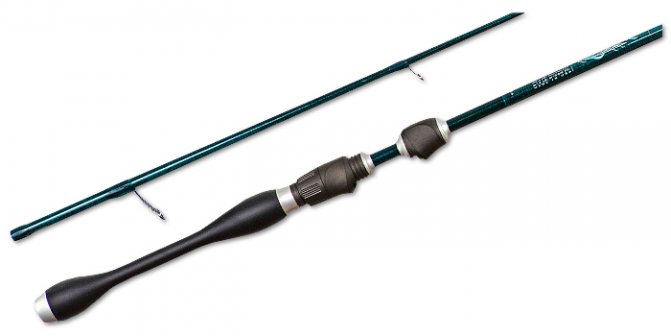
The best professional fishing rod for jigging. Manufacturing is carried out by a popular company that has proven itself only on the positive side. Each element is made of high-quality material, which will not allow the structure to break at the wrong moment, and the handle is made of natural materials, which makes it more ergonomic.
Sensitivity is at the highest possible level, and the casting range is one of the best in the premium segment. Weight – 106 grams. The reel seat also did not stand aside and underwent changes, which increases the service life of the spinning rod several times.
Sold at a price of 30,000 rubles.
Saint Croix Legend XTreme LXS70MF2
Advantages:
- Designed for professionals;
- Durability;
- The handle is made of natural material;
- Weight – 106 grams;
- Durable rings.
Flaws:
- Only for jig.
Find out more about the different models. Reviews about spinning rods
Friends, using our forum, you can find even more information for yourself on the issue of choosing an ultralight spinning rod for microjig.
- Norstream spinning rods
- Spinning rods Graphiteleader
- Aiko spinning rods
- Maximus spinning rods
- Spinning rods Pontoon21
- Evergreen spinning rods
- Ayashi spinning rods (Opus Japan Co., Ltd)
- Spinning rods Favorite
- Spinning rods Black Hole
- Spinning rods Major Craft
Dear fans of #microjig fishing, we hope that all the techniques, facts, secrets and tips described above will help you catch the long-awaited trophy using a spinning rod.
As always, if you have any additions, advice or personal experience, share it in the comments, perhaps it will be useful to beginning spinning players.
Major Craft Solpara SPS-T702M | Price 3,400 rub.
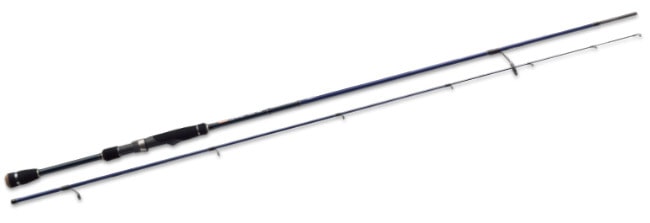
One of the best spinning rods for microjigging is considered to be Major Craft Solpara SPS-T702M . The length of the rod is 2.13 m, weight – 86 g. Despite the fact that the model belongs to the budget version, its design is almost flawless. The assembly is excellent, high sensitivity allows you to feel literally a few grams. The spinning rod is universal - its hollow tip design allows the rod to be used for other types of fishing.
The approximate price of the model is 3,400 rubles.
